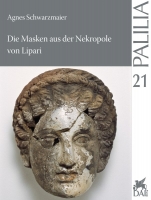Search
Die Masken aus der Nekropole von Lipari
2012
22.0 x 29.0 cm, 256 p., 8 illustrations color, 92 illustrations b/w, weitere 8 farbige und 92 s/w-Abb. auf Tafeln, paperback / softback
ISBN: 9783895007101
22.0 x 29.0 cm, 256 p., 8 illustrations color, 92 illustrations b/w, weitere 8 farbige und 92 s/w-Abb. auf Tafeln, paperback / softback
29,90 €
ISBN: 9783895007101
Short Description
In the necropolis of Lipari (Italy) a great amount of terracotta masks from the 4th and early 3rd century B. C. have been found –– an important local speciality. Their study as products of local coroplast’s workshops is followed by the question of how the masks –– similar to contemporary theatrical masks –– relate to ancient Greek theatre. The investigation of the masks within their context in the necropolis –– here undertaken for the first time –– allows important conclusions on their function and meaning in funerary ritual.Description
The book “Die Masken aus der Nekropole von Lipari” deals with the well-known Classical and early Hellenistic terracotta masks that were found in the necropoleis of the ancient city of Lipari on the Aeolian island of the same name north of Sicily. Most of them were excavated and eventually published over the last 60 years by Luigi Bernabò Brea (†), Madeleine Cavalier, and their team.The masks, which must have been produced on the island, are not only of considerable interest for their great number, artistic quality, and polychromy, but also because they are an important source for our knowledge of the history of the Greek theater and the actual masks, now lost, that were worn by actors during their performances of Greek comedy and tragedy. However, the most important question to ask is just why were these masks found in such quantity immediately outside of the graves in the company of symposium vessels. It is clear that they do not mark tombs of actors, because they also occur in women’s graves.
The first part of this study focuses on the masks themselves as works of coroplasts, their typology, chronology, and iconography. For example, some of the masks had been interpreted as smalescale portraits of Greek dramatists, especially Menander, an interpretation that cannot be maintained, since the masks do not reflect the main features found on securely identified portrait types of these poets. The following chapter deals with the question of the relationship of the masks to the history of Greek theater and the characters of comedy and tragedy. This comprises a discussion of the typological relationship of the masks to the theatrical characters in the lists collected in Book 4 of Pollux’s “Onomasticon”. The position is taken that the lists are not really helpful for a classification of the mask types that have been found in Lipari.
In the second part of this study the masks are examined in relation to their grave contexts in order to understand their function and significance. Conclusions are drawn by examining the contexts and grave goods of the Classical and Hellenistic periods using the methodological and theoretical approaches developed for the modern archaeology of death. An unexpected revelation is the consistency with which the tombs and the grave goods were arranged within the necropoleis of Lipari. The masks normally were found together with a set of symposium vessels that mostly consisted of a cup, an oinochoe, up to four small dishes, and a lamp. All were protected against breakage in a storage vessel or by a cover of clay. The regular position of these sets outside of the southwestern corner of the sarcophagus or urn situated them close to the head of the deceased. This set of symposium pottery must have been placed there during the funeral in a moment when the sarcophagus was closed, but not fully covered with earth. Therefore, it seems that the vessels belonged to the deceased to be used during the funeral, as well as later in the afterlife. In order to understand what took place during the funeral all evidence for funerary ritual in ancient Greece is reconsidered together with its parallels from cultural anthropology, especially in modern Greece.
The masks, which occur only in about 5 percent of all tombs, do not seem to have a relationship to actual performances, but rather appear to have functioned as symbols of Dionysos and his power. Installed at the site of the symposium, they promoted the idea that the god was present during the drinking. This can be demonstrated by looking at the significance of masks in nontheatrical contexts on South Italian vase paintings of the 4th century B.C.
The last chapter examines the role of Dionysos in connection with funerary ritual and the afterlife in Magna Graecia and Sicily. Trying to understand how the Liparians dealt with the death of a close relative and in looking for their ideas concerning death and the afterlife is helpful also for interpreting cemeteries at other Greek sites, since basic rules and fundamental conceptions concerning Greek death and funerary ritual must have existed.
Biographical Note
Agnes Schwarzmaier(* 1962) has studied Classical Archaeology, Ancient History and History of Art in Freiburg i. Br. and Bonn. She wrote her PhD on Greek box mirrors (graduation 1991) and received the Reisestipendium by the German Archaeological Institute. Then she was assistant lecturer at the Institute of Classical Archaeology of the Freie Universität Berlin, where she received the degree of an academic lecturer in 2002 with the present book. Having received several scholarships and an employment with the Corpus Vasorum Antiquorum she is now curator for the treasury and part of the ceramic collection at the Antikensammlung der Staatlichen Museen zu Berlin. Her main field of research is very broad and lies on ancient arts and crafts, the history of ancient theater, and ancient burial customs.




 Preface
Preface

 Neuerscheinungen 2023/2024
Neuerscheinungen 2023/2024
 Gesamtverzeichnis 2023/2024
Gesamtverzeichnis 2023/2024
 Katalog Oriental Studies & Linguistics
Katalog Oriental Studies & Linguistics
 Mittelalter
Mittelalter
 Deutsche Inschriften
Deutsche Inschriften
 Musiktherapie
Musiktherapie
 Literaturen im Kontext
Literaturen im Kontext